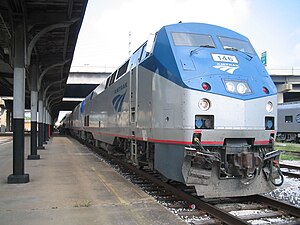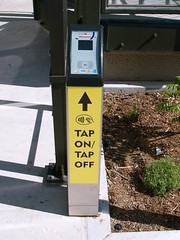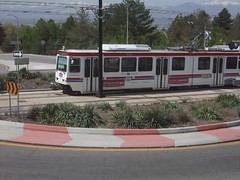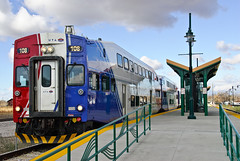 Image via Wikipedia
Image via Wikipedia
This Week at Amtrak; March 23, 2010
A weekly digest of events, opinions, and forecasts from
United Rail Passenger Alliance, Inc.
America’s foremost passenger rail policy institute
1526 University Boulevard, West, PMB 203 • Jacksonville, Florida 32217-2006 USA
Telephone 904-636-7739, Electronic Mail info@unitedrail.org • http://www.unitedrail.org
Volume 7, Number 10
Founded over three decades ago in 1976, URPA is a nationally known policy institute which focuses on solutions and plans for passenger rail systems in North America. Headquartered in Jacksonville, Florida, URPA has professional associates in Minnesota, California, Arizona, New Mexico, the District of Columbia, Texas, New York, and other cities. For more detailed information, along with a variety of position papers and other documents, visit the URPA web site at http://www.unitedrail.org.
URPA is not a membership organization, and does not accept funding from any outside sources.
--------------------------------------------------------------------------------
Volume 7, Number 10
Before we begin this week, a note from Bruce Richardson:
Amtrak will lose one of its most important human assets at the end of this month. Cliff Black, long the public face of Amtrak and its long serving spokesman is retiring after decades of service. He will be greatly missed by all of us who have known him professionally, and by those who have worked directly with him.
During his tenure at Amtrak there have been too many presidents of the company who have come and gone to keep count of, but, through each change of leadership at Amtrak the one constant has been Mr. Black’s deft handling of the news media and corporate communications. Any of us seeking true, honest information knew Cliff Black was the man to talk to; while keeping on message for his employer, he never led anyone in the news media astray, an amazing feat in today’s world of journalism.
A phone call to or from Cliff Black is always a few moments of pleasant diversion. A written message from him is always an honest missive, whether it contains good or bad news.
So, Mr. Black heads into the next part of his life, leaving the corporate world behind. All of us thank him profusely for his service to Amtrak and good journalism, and wish him well for the future. If his successor is just half as good at what Mr. Black does, then his successor will be a great success.
# # #
An ocean liner does not turn on a dime, and neither does a large corporation. Some parts of Amtrak are definitely changing course while others have not yet caught up.
Starting with the positive, we hear a few weeks ago that real china, linens, and glassware are returning to the Coast Starlight. This is certainly a good bit of news, and part of a refocusing on passenger needs. One wonders, however, how many surveys are required to determine that folks shelling out the equivalent of a fairly posh hotel room in most American cities, for their “first class” railway accommodations, expect a table setting in the diner to more closely approximate something saying “Lenox” than “Dixie Cup Company.” We do extend a note of approval to Mr. Brian Rosenwald, Chief of Product Development, and all those involved in the recent changes on the Starlight.
Then we hear from Amtrak spokesman Mark Magliari that Amtrak is also evaluating the Capitol Limited in a not dissimilar manner, looking also at the schedule. An article in the Cleveland Plain Dealer invites residents of that city to request Amtrak consider changing the wee-hour stops to something more amenable to civilized travel. We further commend the company for such recent emphasis on listening to advocates, railfans, and (gasp!) even their own potential customers, and fervently hope to see more “doing more with what we have.”
The key to Amtrak solving its financial and public-relations challenges will be getting more people on its trains — not just “doing more,” but adding capacity. Again we see positive developments in the rehabilitation of wrecked Superliners and an order for Viewliners… the beginning of what needs to be a long road.
Speaking of alternatives to wee-hour schedules, and doing more with existing routes and stations, we can now thank www.timetables.org — a new web site which has scanned all Amtrak’s historic timetables — for providing proof that, once upon a time, Amtrak operated at least one of its Western long distance trains on a twice-daily basis. Page 52 of the June 11, 1972 timetable shows both the Chief and the Super Chief operating Chicago-Los Angeles, on schedules several hours apart. Any railfan younger than 50 years old probably never knew this; certainly the popular railfan magazines never mentioned the fact in all the years I read them. One could well imagine all long-distance routes past the Eastern seaboard with two daily trains, spaced by eight or ten hours, providing convenient times in most every origin-destination pair… doubling revenue with little increase in station or system costs.
David Carleton writes,
At the very beginning of Amtrak, the railroads were still the operating agents running trains “for” the National Railroad Passenger Corporation. The Santa Fe and the SCL did at first add trains to the schedule during periods when they knew there would be heavier traffic…
In 1971, the El Capitan / Super Chief ran with six Hi-Level coaches containing 424 seats, and six sleeping cars containing eighty rooms with a total of 132 berths.
The Chief which ran in 1972 carried three Hi-Level coaches containing 208 seats and two sleeping cars of various configurations.
By 1975 the same operation (but renamed the Southwest Limited when a disgusted Santa Fe withdrew the rights to the traditional names) was down to three Hi-Level coaches containing 208 seats and three sleeping cars containing fifty-nine rooms with a total of 88 berths.
Remember, the year 1973 saw the Arab Oil Embargo, rationed gasoline, and folks looking for any alternative to driving. Little Japanese cars like the Honda CVCC (later the Civic) were all the rage, as Detroit rushed the Vega and the Pinto to market. Where were 1972’s second frequencies on 1973’s Amtrak? Mr. Carleton writes, “We can confirm based on our own direct observations that none of those trains ran empty!” Have we yet truly overcome obstacles to expanding our country’s passenger trains?
Judging by the past week’s Kansas rail study — no. The Lawrence (Kansas) Journal-World reports — http://www2.ljworld.com/news/2010/mar/11/amtrak-study-shows-routes-through-kansas/ — that “Ridership numbers have good potential, but [the] effort” to carry passengers between Kansas City and Fort Worth “will take years, officials say.” The study considered four options with start-up costs ranging from about $150 to $500 million (exclusive of stations), projecting 65,000 to 174,000 annual riders.
John Mills of Topeka noted in a forum elsewhere on the Internet that the study includes the addition of a second main track to 40 miles of the BNSF railway, at four million dollars a mile, rather than a more sensible six mile stretch of double-track and one new passing siding. Much more than that, he argues, is more a pure benefit to freight movement than a mitigation of the relative few minutes of delay introduced by a couple daily passenger trains, and thus should be partly paid for by BNSF itself. Bluntly, just as with last year’s flawed system expansion reports (the Sunset Limited east of New Orleans, the Pioneer and the North Coast Hiawatha) the Kansas study overstates the obstacles and understates the potential to get something moving quickly while seriously working with the railroads to improve even further. There’s much more to say about this, next time.
On the High Speed Rail front, Scott McCartney’s “blog” on the Wall Street Journal website ( http://blogs.wsj.com/middleseat/2010/03/09/lahood-to-airlines-get-onboard-the-high-speed-train/ ) noted that Transportation Sec. Ray LaHood, addressing the Federal Aviation Administration’s annual forecasting conference in Washington, D.C., said that within a few decades, American cities will be connected by high-speed rail – “whether airlines like it or not. ‘People want alternatives,’ he [LaHood] said pointedly. ‘People are still going to fly, but we need alternatives. So get with the program.’”
On the heels of Mr. LaHood’s comments comes an employee advisory from Mr. Boardman at Amtrak on Friday 19 March, regarding a new High-Speed Rail department at Amtrak to “be led by a vice president reporting directly to me.” The press release continues,
Specifically, this department will work on the planning and development activities that will allow us to significantly increase operating speeds above 150 mph (240 kph) on the Northeast Corridor. It will also pursue partnerships with states and others in the passenger rail industry to develop federally-designated high-speed rail corridors such as the new projects moving forward in California and Florida.
Amtrak’s leadership in this area is reaffirmed in the Passenger Rail Investment and Improvement Act of 2008 and we must make every effort to remain in that position.
That last paragraph sounds curiously aware of potential competition from the private high-speed railway operators of Europe and other shores. Who says competition is a bad thing?
Finally, and on this subject, we hear from Mr. Daniel Carleton. Until next week, gentle readers.
– \\/
William Lindley, Scottsdale, Ariz.
A Tale of Two (High-Speed) Rails; a lesson of pragmatism vs. phantasm
by Daniel Carleton
The awarding of the American Recovery and Reinvestment Act grants (ARRA) for High-Speed Rail projects has ended many months of speculation how the funds would be allocated. In all, $8 billion has been sown toward expanded and improved passenger rail service in America. The big winner is California with $2.3 billion going toward various projects, including a very small down-payment for their $45 billion HSR system. In comparison, Illinois, considered an early crony favorite, only picked up $1.1 billion; strange considering Chicago is the railroad hub of America.
However, there are two states which are poles apart in their passenger rail ambitions and ARRA grant requests: Wisconsin and Florida. Wisconsin is on tap to receive $822 million; the vast majority of this to reinstate service between Milwaukee and Madison, 80 miles. Florida sees things somewhat differently. The Sunshine State is bequeathed $1.25 billion for preliminary engineering on a high-speed railway between Tampa and Orlando, 84 miles. Why does four miles add $428 million to the tab? Moreover, the total estimated cost of the Tampa – Orlando route is $3.5 billion. Can both these plans be realistic?
In Wisconsin the idea is rather straightforward: reinstate passenger traffic between the state capitol, Madison, and the state’s largest city, Milwaukee. The right-of-way historically is former Milwaukee Road; part of the route, Milwaukee to Watertown, sees Amtrak’s daily Empire Builder. West of Watertown, the line is now governed by the Wisconsin & Southern Railroad, a local regional road. The Badger State has already committed $47 million dollars of state funds for two new fourteen-car TALGO trainsets to support their existing Chicago – Milwaukee service. Ostensibly, two more trainsets will be ordered to support this further expansion in service, and the concurrent increase in speeds to 110 mph, all of which is expected to be running by 2013.
Florida, in contrast, has opted to reinvent the flanged wheel by building an entirely separate railroad between Orlando and Tampa, as part of a larger goal of extending the system to Miami. The initial phase would see a new right-of-way established between or near the lanes of Interstate Highway 4. New stations would be built even though numerous ones already exist. A new station is planned for Walt Disney World even though Disney’s involvement has been the kiss of death for all previous HSR incarnations in Florida. Preliminary engineering is expected to be finished by 2011 and service by 2014.
The desire to utilize existing highway rights-of-way is manifold. On top of this list is the low-to-nonexistent cost of land acquisition. Yet, a brief look at the historical economic impact of highways should be reviewed before proceeding. When a new highway was built there was a positive financial influence; land at or near interchanges and exits became more valuable and businesses were built. However, over time traffic increased and transit times increased to the point of highway expansion. What was the economic impact of new lanes to an existing highway? Practically nil. The land at the interchanges and exits didn’t move and any extra business practiced comes no where near to paying for the lane addition. Does anyone realistically expect building a railroad adjacent to a highway, high-speed or otherwise, to have any different an effect? If built as planned, Florida’s HSR stations will be built at or near existing development. Whereas heavy construction will gain a short-term production there will be no long-term development. Is this worth $3.5 billion?
There is an existing railroad between Tampa and Orlando with a daily scheduled Amtrak train. The right-of-way is owned by CSX and is predominantly a secondary route to Tampa. (A small section between Lakeland and Auburndale will increase in importance once a new yard in Winter Haven is completed.) This former Atlantic Coast Line trackage rolls through the heart of numerous well established central Florida towns such as Plant City, Lakeland, and Kissimmee; Lakeland having built a brand new station in 1998. Anchoring the west end of this corridor is Tampa Union Station, which was completely renovated and dedicated also in 1998. Orlando does not currently have the best station for the riding public. This situation which will change with the coming of SunRail commuter train service and a new intermodal station built downtown; Lynx Central Station. As of right now none of this existing infrastructure is slated to be utilized for Florida’s HSR ambitions. Is this really an act of recovery or reinvestment?
What if Florida were to, instead of reinventing the flanged wheel, rebuild the existing corridor? The existing highway and its associated development will not go away; the fast food restaurants, big box stores and movie multiplexes are not likely to blow away with the wind. Rebuilding the existing railroad would mean an opportunity for growth to the towns and cities who owe their origins to the railroad. Downtown Tampa, where Union Station is already situated, could once again be made vibrant. Similar could be said of the smaller towns which atrophied or shrank in the highway age. What this means is jobs. Already development is seen, either on the ground or on the drawing board, around the area to be served by SunRail. There is no reason this cannot be expanded west. What does it say about governance when glitzy ambitions are placed ahead of the people’s needs?
--------------------------------------------------------------------------------
If you are reading someone else’s copy of This Week at Amtrak, you can receive your own free copy each edition by sending your e-mail address to
freetwa@unitedrail.org
You MUST include your name, preferred e-mail address, and city and state where you live. If you have filters or firewalls placed on your Internet connection, set your e-mail to receive incoming mail from twa@unitedrail.org; we are unable to go through any approvals processes for individuals. This mailing list is kept strictly confidential and is not shared or used for any purposes other than distribution of This Week at Amtrak or related URPA materials.
All other correspondence, including requests to unsubscribe should be addressed to
wlindley@unitedrail.org
Copies of This Week at Amtrak are archived on URPA’s web site, www.unitedrail.org
URPA leadership members are available for speaking engagements.
 Image by Steven Vance via Flickr
Image by Steven Vance via Flickr![Reblog this post [with Zemanta]](http://img.zemanta.com/reblog_e.png?x-id=e6e352fa-d15b-4432-83a3-269566c7ac2c)

![Reblog this post [with Zemanta]](http://img.zemanta.com/reblog_e.png?x-id=ac1fb77e-b847-4ac4-854e-a6375da92b21)

![Reblog this post [with Zemanta]](http://img.zemanta.com/reblog_e.png?x-id=2055a61f-6af1-47f1-91b7-be7edaefee28)

![Reblog this post [with Zemanta]](http://img.zemanta.com/reblog_e.png?x-id=e23b2c41-7618-4a0a-8542-445ef2e6ccd1)

![Reblog this post [with Zemanta]](http://img.zemanta.com/reblog_e.png?x-id=0c0ab148-201a-4271-b913-19174c03e545)

![Reblog this post [with Zemanta]](http://img.zemanta.com/reblog_e.png?x-id=a5903104-041d-4677-b39d-ba4d5344be88)

![Reblog this post [with Zemanta]](http://img.zemanta.com/reblog_e.png?x-id=60cb7428-c2b6-4d6b-af12-4c2d82555096)

![Reblog this post [with Zemanta]](http://img.zemanta.com/reblog_e.png?x-id=93692e7d-68a7-46dd-be8a-3c5fc662f58c)

![Reblog this post [with Zemanta]](http://img.zemanta.com/reblog_e.png?x-id=dd6b382f-b409-4264-8849-b590aa602586)

![Reblog this post [with Zemanta]](http://img.zemanta.com/reblog_e.png?x-id=382cf073-ff91-46c9-91df-7465c3e2416f)

![Reblog this post [with Zemanta]](http://img.zemanta.com/reblog_e.png?x-id=b46514e1-d706-4bed-a5dd-b0a9612eaa4f)